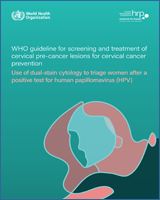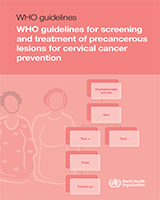Annex 7Reference list of all studies included in the evidence reviews
Studies on diagnostic test accuracy
Studies on baseline risks included in the model
Arbyn M, et al. Evidence regarding human papillomavirus testing in secondary prevention of cervical cancer.
Vaccine. 2012;30 Suppl 5:F88–99. [
PubMed: 23199969]
Denny L, et al. Human papillomavirus infection and cervical disease in human immunodeficiency virus-1-infected women.
Obstetrics & Gynecology. 2008;111(6):1380–1387. [
PubMed: 18515522]
De Vuyst H, et al. HIV, human papillomavirus, and cervical neoplasia and cancer in the era of highly active antiretroviral therapy.
European Journal of Cancer Prevention. 2008;17(6):545–554. [
PubMed: 18941376]
De Vuyst H, et al. Prevalence and determinants of human papillomavirus infection and cervical lesions in HIV-positive women in Kenya.
British Journal of Cancer. 2012;107(9):1624–1630. [
PMC free article: PMC3493776] [
PubMed: 23033006]
GLOBOCAN 2008 [online database]. France: World Health Organization, International Agency for Research on Cancer; 2010. [15 August 2013].
http://globocan.iarc.fr/ Joshi S, et al. Screening of cervical neoplasia in HIV-infected women in India.
AIDS. 2013;27(4):607–615. [
PubMed: 23079814]
Sankaranarayanan R, et al. Osmanabad District Cervical Screening Study Group. A cluster randomized controlled trial of visual, cytology and human papillomavirus screening for cancer of the cervix in rural India.
International Journal of Cancer. 2005;116(4):617–623. [
PubMed: 15818610]
Zhang HY, et al. HPV prevalence and cervical intraepithelial neoplasia among HIV-infected women in Yunnan Province, China: a pilot study.
Asian Pacific Journal of Cancer Prevention. 2012;13(1):91–96. [
PMC free article: PMC3809115] [
PubMed: 22502720]


